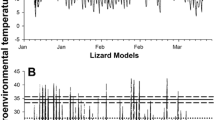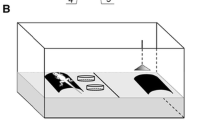Abstract
Viviparity (live-bearing) in reptiles often is interpreted as an adaptation to cold climates. This hypothesis relies on (i) body temperatures of gravid females being higher than soil (nest) temperatures; (ii) embryonic development being accelerated by this temperature difference; and (iii) survivorship of hatchlings being increased if eggs hatch before the advent of cold weather in autumn. I gathered data to test these assumptions, using eight species of scincid lizards in a high-elevation area of southeastern Australia.
Due to behavioural thermoregulation, body temperatures of gravid lizards average ca. 7°C higher than soil (nest) temperatures. Oviparous female lizards retain eggs in utero for ca. 50% of development. Laboratory studies show that a temperature increase from 17°C (mean nest temperature) to 24°C (mean lizard temperature) reduces incubation periods of eggs by >40 days in heliothermic species, and <20 days in a thigmothermic species. In the field, soil temperatures drop to lethally low levels shortly after the usual time of hatching. Simple calculations show that without the acceleration of development caused by uterine retention, eggs could not hatch prior to the onset of these low temperatures in the field. These results support the major assumptions of the “cold climate hypothesis” for the evolution of reptilian viviparity.
Similar content being viewed by others
References
Dufaure JP, Hubert J (1961) Table de developpement du lézard vivipare: Lacerta (Zoótoca) vivipara Jacquin. Arch Anat Microscop Morphol Exp 50:309–328
Fitch HS (1970) Reproductive cycles in lizards and snakes. Univ Kansas Mus Nat Hist Misc Publ 52
Fitch HS, Fitch AV (1967) Preliminary experiments on physical tolerances of the eggs of lizards and snakes. Ecology 48:160–165
Fraser SP (1980) Insights into the physiological and behavioural thermoregulatory abilities of small lizards. Unpublished B. Sc. (Hons.) thesis, Zoology, University of Sydney
Greene HW (1970) Modes of reproduction in lizards and snakes of the Gomez Farias region, Tamaulipas, Mexico. Copeia 1970:565–568
Greer AE (1968) Mode of reproduction in the squamate faunas of three altitudinally correlated life zones in east Africa. Herpetologica 24:229–232
Mell R (1929) Beitrag zur Fauna sinica. IV. Grundzüge einer Okologie der chinesischen Reptilien und einer herpetologischen Tiergeographe Chinas. Berlin
Neill WT (1964) Viviparity in snakes: some ecological and zoogeographical considerations. Am Nat 98:35–55
Neill WT (1971) The last of the ruling reptiles. Columbia University Press, New York
Packard GC (1966) The influence of ambient temperature and aridity on modes of reproduction and excretion of amniote vertebrates. Am Nat 100:677–682
Packard GC, Tracy CR, Roth JJ (1977) The physiological ecology of reptilian eggs and embryos, and the evolution of viviparity within the class Reptilia. Biol Rev 52:71–105
Pengilley RK (1971) Calling and associated behaviour in some species of Pseudophryne (anura: Leptodactylidae). J Zool Lond 163:73–92
Pengilley RK (1972) Systematic relationships and ecology of some lygosomine lizards from southeastern Australia. Unpublished doctoral dissertation, Australian National University
Rawlinson PA (1974a) Biogeography and ecology of the reptiles of Tasmania and the Bass Strait area. pp. 230–269. In: Williams WD (ed) Biogeography and ecology in Tasmania. Monographie Biologicae 24, The Hague, Junk
Rawlinson PA (1974b) Revision of the endemic south-eastern Australian lizard genus Pseudemoia (Scincidae: Lygosominae). Mem Natn Mus Vict 35:87–96
Rawlinson PA (1975) Two new lizard species from the genus Leiolopisma (Scincidae: Lygosominae) in southeastern Australia and Tasmania. Mem Natn Mus Vict 36:1–16
Robertson P (1981) Comparative reproductive ecology of two south-eastern Australian skinks. In: Banks CB, Martin AA (eds), Proceedings of the Melbourne herpetological symposium, Zoological Board of Victoria. pp 25–37
Sergeev AM (1940) Researches on the viviparity of reptiles. Mosc Soc Nat (Jubilee Issue): 1–34
Shine R (1980) “Costs” of reproduction in reptiles. Oecologia 46:92–100
Shine R (1983) The evolution of viviparity in reptiles. Invited chapter for “Biology of the Reptilia” Gans C and Billett F (ed), in prep
Shine R, Berry JF (1978) Climatic correlates of live-bearing in squamate reptiles. Oecologia 33:261–268
Shine R, Bull JJ (1979) The evolution of live-bearing in lizards and snakes. Amer Nat 113:905–923
Tinkle DW (1967) The life and demography of the side-blotched lizard, Uta stansburiana. Misc Publ Mus Zool Univ Michigan 132:1–182
Tinkle DW, Gibbons JW (1977) The distribution and evolution of viviparity in reptiles. Misc Publ Univ Mich 154:1–55
Weekes HC (1935) A review of placentation among reptiles with particular regard to the function and evolution of the placenta. Proc Zool Soc Lond 1935:625–645
Zweifel RG (1968) Reproductive biology of anurans of the arid south-west, with emphasis on adaptation of embryos to temperature. Bull Amer Mus Nat Hist 140:1–64
Author information
Authors and Affiliations
Rights and permissions
About this article
Cite this article
Shine, R. Reptilian viviparity in cold climates: testing the assumptions of an evolutionary hypothesis. Oecologia 57, 397–405 (1983). https://doi.org/10.1007/BF00377186
Received:
Issue Date:
DOI: https://doi.org/10.1007/BF00377186




